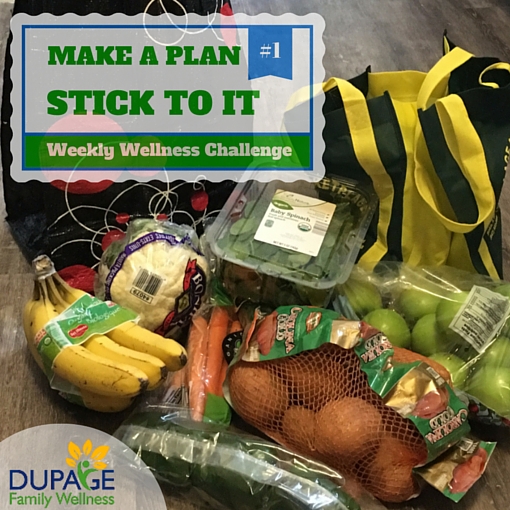
Eat The Rainbow
It is easy it is to get stuck in a rut, eating the same foods. This week, focus on branching out! As you grocery shop, admire at all the colors in the produce department. Buy something new! Fill your cart with foods of different colors.
Why is eating a variety of colors important?
Foods of each color have different nutrients and properties. We need ALL of the colors to get all the nutrients that our bodies need to be healthy.
Red
Red produce is known for its cancer fighting properties. The reds provide an abundance of antioxidants, including high doses of vitamin C, flavonoids, lycopene, and anthocyanin.
Examples of RED: Apples, beets, bell peppers, red cabbage, cayenne peppers, cherries, cranberries, grapes, pomegranates, radicchio, radishes, raspberries, rhubarb, ruby red grapefruit, strawberries, tomatoes, watermelon.
Orange
Orange fruits and vegetables are known for their beta-carotene, which is the precursor to vitamin A. This is essential for night vision and also neutralizes free radicals in the body making it crucial for boosting the immune system. Orange vegetables are another powerhouse of Vitamin C.
Examples of ORANGE: Butternut squash, cantaloupe, carrots, guava, loquats, kumquat, mandarin, mango, nectarines, orange bell pepper, oranges, papaya, persimmon, peach, pumpkin, sweet potato, tangerines, winter squash.
Yellow
We all love this sunny color. Yellow fruits and vegetables are bursting with carotenoids and bioflavanoids and more vitamin C. Studies have found that eating YELLOW is beneficial to your heart, vision, digestion and immune system.
Examples of YELLOW: Lemons, bananas, yellow summer squash, delicata squash, pineapple, star fruit, mangoes, endive, yellow peppers, onions, chamomile, yellow tomatoes, turmeric, mustard seeds, spaghetti squash, Crenshaw melon
Green
If you had to pick one color to provide you with the most nutrient density, green is your color! Eating dark greens are known for:
- Naturally reducing cholesterol
- Providing antioxidants with immune system boosters and anti-cancer properties
- Providing mood boosting B vitamins
- Preventing osteoporosis more effectively than milk. Greens provide calcium along with the potassium, magnesium and other minerals to build strong bones.
Examples of GREEN: Arugula, bok choy, broccoli, cabbage, brussel sprouts, collard greens, lettuces, kale, mustard greens, escarole, turnip greens, beet greens, watercress, spinach, swiss chard, parsley, cilantro, artichokes, green summer squash, cucumbers, kiwi, celery.
Blue / Purple
The USDA has named blueberries the fruit highest in antioxidants. The powerful antioxidants present in blue and purple fruits and veggies help prevent oxidative cell damage, thus reducing the risk of Alzheimer’s, heart disease, and cancer. Anthocyanin in dark blue and purple fruits and vegetables helps to improve memory, and the flavonoids present help to metabolize bacteria in the arteries and improve circulation to reduce the risk of heart disease. Furthermore, the antioxidants neutralize free radicals, preventing cell damage and cancer causing tumors. One added benefit of the blues and purples are the rich flavonoids, which help prevent urinary tract infections.
Examples of BLUE/PURPLE: Blueberries, blackberries, cranberries, eggplant, figs, plums, purple potatoes, grapes, prunes.
This week aim to fill your grocery cart with a rainbow of produce (no, Skittles do not count). Your goal is to eat at least 2 colors at each meal! Let us know how it goes on our facebook page.
Joelle Kurczodyna, NTP
 Everyone should consume probiotics to maintain good digestion and gut health. You may think that this means taking a pill or supplement, but my preferred method of ingesting these "good" bacteria is through the food that you eat! In fact, probiotics were part of the regular diet in previous generations.
Everyone should consume probiotics to maintain good digestion and gut health. You may think that this means taking a pill or supplement, but my preferred method of ingesting these "good" bacteria is through the food that you eat! In fact, probiotics were part of the regular diet in previous generations.
Probiotics are beneficial bacteria contained in fermented foods. Before refrigerators and modern food storage, fermenting was used to preserve food. During fermentation, natural bacteria feed on the sugars and starches in the food creating lactic acid. Lactic acid not only preserves the food, it also makes it more digestible and preserves and increases beneficial enzymes, nutrients, and beneficial bacteria (probiotics). As convenience and processed foods have overtaken our pantries, we have stopped eating these healthful and traditional fermented foods, and our probiotic consumption has declined, as well.
Why Make and Eat Your Own Fermented Foods
- Increase probiotics. Probiotics provide your digestive system with bacteria that has been known to have tremendous benefits including improving your immune system, helping digestion, balancing hormones, and even slowing or eliminating disease.
- Makes food more digestible and easily absorbed. The process of fermentation begins to breakdown food naturally, making it easier to digest. The fermented food also provides the bacteria and digestive enzymes to help your body absorb all the good nutrients packed other real food that you eat.
- Save money. Finding a good brand of fermented foods that does not contain added ingredients is often difficult, and usually these products are expensive. However, it is budget friendly to make your own fermented foods, using a few simple ingredients. You would no longer purchase probiotic supplements, and the health benefits of probiotics could save you future medical expenses.
What fermented food to make?
It is easy to ferment most fruits and vegetables by cutting them up, mixing them with salt and spices, pounding them to release juices, and then storing them in an air tight container. You can find hundreds of recipes for doing this by searching "lactofermented" with the name of the food you would like to ferment.
Two super simple fermented foods that are a part of our regular diet are homemade yogurt and sauerkraut.
Homemade Crockpot Yogurt
Ingredients:
- ½ gallon of whole fat organic milk
- ½ cup of PLAIN yogurt (only ingredients are milk and cultures) Read the ingredients, and you will see the cultures listed.
Note: Typical flavored yogurt, including vanilla yogurt, does not have these cultures. Learn more about yogurt here.
Directions:
- Pour ½ gallon of milk into crockpot and cook on LOW.
- After 2.5 hours turn crockpot off and let sit for 3 hours without removing the lid.
- Once the additional 3 hours has passed, quickly remove lid and stir in ½ cup of plain yogurt into the warm milk.
- Set lid back on and wrap crockpot in two large bath towels.
- Let sit on counter for around 12 hours, or overnight.
- Store yogurt in glass quart size mason jars. The yogurt will continue to thicken to desired texture after being refrigerated for 4-6 hours.
Add your favorite fresh fruits and nuts. Enjoy!
Don't forget to reserve 1/2 cup to start your next batch.
Traditional Sauerkraut
Ingredients:
- 1 head of cabbage
- 2 tbsp sea salt
Directions:
- Core and shred cabbage.
- In a large bowl mix cabbage with salt.
- Pound with meat hammer or use your hands to massage juices from cabbage. This can take 10-20 minutes, be patient!
- Place cabbage in juices into a wide mouth mason jar making sure that the juices cover the cabbage and that you leave at least one inch of head space at the top of the jar.
- Cover tightly and store counter for three days then move to refrigerator.
What other fermented foods do you eat? Kimchi? Pickle your own cucumbers? Beets? Talk to us about it on our facebook page, and good luck with this week's challenge.
 We’ve all been there.
We’ve all been there.
Five o’clock rolls around, it has been a crazy day running around without a thought about dinner. Now, you are hungry and your family is starting to ask …hmm…take out sounds good, maybe grab some fast food on the way to evening activities, or I think there’s a frozen pizza in the freezer.
In spite of our best intentions, this scenario happens more than we want to admit. So, how do we avoid it?
Planning ahead has been a lifesaver for me to get around the 5 o’clock and nothing to eat problem. In fact, it’s been so effective; I plan all of our meals now.
How does it work? Follow these three easy steps: plan, shop, and cook!
Plan:
- Think through your week: Which days do you have more time to prepare food, and which days will you be crunched for time? Those time crunch days are great for crock meals, throwing together a salad, or simply reheating an already prepared dish.
- Involve the whole family: When I was a kid, our family did weekly “dinner nights”. Each member of the family chose a meal that our family would have that week. When it was your dinner night, you were in charge of cooking or at least helping to cook your meal of choice.
- Cook a big batch of something: Use extra meat for several meals throughout the week. You will see this strategy in my meal plan for this week below.
- Remember to use simple whole food ingredients: Avoid canned, bottled, and other packaged foods with a long list of ingredients. Think about easy, healthy snacks to have on hand; fruits, nut butters, veggies, guacamole, and hard boiled eggs are some of our favorites.
Once you have your plan for the week, it’s time to shop!
Shop:
Based on your meal plan, make a list of ingredients that you need to buy to execute your plan. Having a plan and all of the ingredients on hand takes away excuses. You don’t have to think when dinner time comes; you know what you will be having and have the ingredients to make it.
Cook:
Here’s where it comes together. Take your plan, your ingredients and cook a wonderful dinner. With my current unpredictable schedule, I choose meals that I can prepare in advance because I often don’t know whether cooking at dinner time will be an option with a new baby. Often, I whip up dinner while the baby is sleeping or before my husband leaves for work in the morning and I have extra help. Later, I cook it. Figure out what works best for you and your family and do that!
What does this actually look like? Here is my meal plan this week!
| |
Breakfast |
Lunch |
Dinner |
| Sunday |
Butternut squash and spinach hash topped with 2 eggs. |
Plantain Lasagna |
Pork shoulder roast with potatoes, carrots, and onions in crock pot with roasted asparagus. |
| Monday |
Butternut squash and spinach hash topped with 2 eggs. |
Plantain Lasagna |
Italian Stuffed Peppers |
| Tuesday |
Egg Casserole (we used sausage, sweet potatoes, spinach, onions, and eggs) |
Plantain Lasagna |
Leftover Pork Roast and asparagus. |
| Wed. |
Egg Casserole |
Leftover Pork Roast |
Italian Stuffed Peppers |
| Thur. |
Egg Casserole |
Plantain Lasagna |
Roasted salmon, broccoli, and sweet potatoes |
| Friday |
Sweet potato topped with 2 eggs and avocado |
Salmon, broccoli and sweet potatoes |
Brown rice sourdough pizza (a Friday night tradition) |
| Saturday |
Sweet potato topped with 2 eggs and avocado |
TBD |
TBD |
Dr. Jamie's meal plan for the week.
| |
Breakfast |
Lunch |
Dinner |
| Sunday |
Eggs with vegetables - each day choose several from sweet potato, green pepper, onion, zucchini, and leftover veggies from dinner that are not needed for lunch (e.g. spaghetti squash)
|
Lunch at a friend’s house |
Grilled Lots of Chicken to use all week
Chicken in a salad with homemade honey mustard, avocado, and tomato.
|
| Monday |
same |
Most lunches are leftovers from last night's dinner - Pack the lunch right after dinner. |
Salad with grilled chicken, onion, red pepper, carrots, and homemade Asian dressing. |
| Tuesday |
same |
same |
Grilled chicken with Spaghetti squash, shredded carrots, shredded zucchini, and onions cooked in a coconut milk curry sauce |
| Wed. |
same |
same |
Pork steaks with roasted broccoli and coleslaw. |
| Thur. |
same |
same |
Jamie- sweet potato with avocado. Jared out |
| Friday |
same |
Salad with pork steak |
Butternut squash soup and salad. |
| Saturday |
Breakfast casserole |
TBD |
TBD |
Some notes on how I create our meal plan:
- As you can see, we LOVE leftovers. I will often cook big batches of things that we will eat it several times throughout the week (egg casserole, plantain lasagna, roast, and stuffed peppers)
- Every day, I aim to eat at least 5 servings of vegetables and make sure to eat fruits and vegetables from a variety of different colors (Eat the rainbow!)
- I usually leave a few meals at the end of the week “to be determined”. This gives us room for flexibility to shift things around if something comes up. and if not; we get creative and throw something together! I make sure we eat EVERYTHING that I bought for the week. I plan to use it before buying more food for the next week so that nothing is wasted.
So there you have the first weekly wellness challenge. Go forth and plan your meals for the coming week! What tips and tricks do you use to create a meal plan? Let us know on our facebook page.
Author: Joelle Kurczodyna, NTP



 Everyone should consume probiotics to maintain good digestion and gut health. You may think that this means taking a pill or supplement, but my preferred method of ingesting these "good" bacteria is through the food that you eat! In fact, probiotics were part of the regular diet in previous generations.
Everyone should consume probiotics to maintain good digestion and gut health. You may think that this means taking a pill or supplement, but my preferred method of ingesting these "good" bacteria is through the food that you eat! In fact, probiotics were part of the regular diet in previous generations. We roast a whole chicken about every other week. It’s easy, nourishing, and can be stretched into several meals in our
We roast a whole chicken about every other week. It’s easy, nourishing, and can be stretched into several meals in our 
 We’ve all been there.
We’ve all been there.